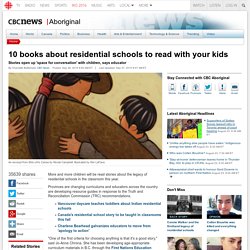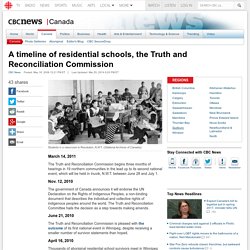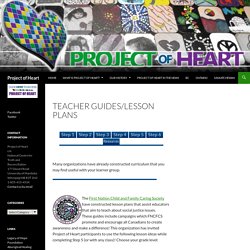

Indian Residential Schools and Reconciliation Resources - FNESC. The Indian Residential Schools and Reconciliation Teacher Resource Guides for grades 5, 10 and 11/12 were developed by the First Nations Education Steering Committee and the First Nations Schools Association.

They are our response to the call by the Truth and Reconciliation Commission of Canada for education bodies to develop age-appropriate educational materials about Indian residential schools. It is our hope that these resources will help students of all cultural backgrounds gain an understanding of the history of the relationship between Indigenous and non-Indigenous people over Canada’s history, with a focus on the BC experience.
Heritage Minutes Dive Into 'Darker Chapters' Of Canada's History. Two new Heritage Minutes released Tuesday focus on significant moments in Indigenous history.

The clips, produced by Historica Canada, were written by acclaimed author Joseph Boyden, according to a press release. One of the videos tells the story of Chanie Wenjack, an Anishinaabe boy who ran away from the Cecilia Jeffrey Indian Residential School in 1966 and died during his escape to go home. 'Chanie wanted to go back home' Residentiall%20School%20Reading%20List. 10 books about residential schools to read with your kids - Aboriginal - CBC. More and more children will be read stories about the legacy of residential schools in the classroom this year.

Provinces are changing curriculums and educators across the country are developing resource guides in response to the Truth and Reconciliation Commission (TRC) recommendations. "One of the first criteria for choosing anything is that it's a good story," said Jo-Anne Chrona. She has been developing age-appropriate curriculum materials in B.C. through the First Nations Education Steering Committee (FNESC). It opens up that space for conversation. - Jo-Anne Chrona, educator For parents reading these books at home to their children, Chrona says it's important to be mindful of what's appropriate, emotionally and developmentally.
"Talk with your children about what it is that they're reading, what it is that they understand," she said. "It opens up that space for conversation. " Truth and Reconciliation Commission of Canada (TRC) It is difficult to place an exact figure on the number of residential schools to which Aboriginal people have been sent in Canada.

While religious orders had been operating such schools before Confederation in 1867, it was not the 1880s that the federal government fully embraced the residential school model for Aboriginal education. While the government began to close the schools in the 1970s, the last school remained in operation until 1996. For purposes of providing compensation to former students the Indian Residential School Settlement Agreement has identified 139 residential schools.
(Despite the fact that the agreement is titled the Indian Residential Schools Settlement Agreement, the lives of First Nations, Métis, and Inuit people were all touched by these schools.) A timeline of residential schools, the Truth and Reconciliation Commission. Students in a classroom in Resolution, N.W.T.

((National Archives of Canada)) March 14, 2011 The Truth and Reconciliation Commission begins three months of hearings in 19 northern communities in the lead up to its second national event, which will be held in Inuvik, N.W.T. between June 28 and July 1. Nov. 12, 2010. 100 Years of Loss. The following reading list is a selection of the growing number of publications that document the history and legacy of residential schools.

It is by no means complete and is a work in progress. For Younger Readers Ages 4–8 Campbell, Nicola I., with illustrations by Kim LeFave. Shin-chi’s Canoe. Toronto, ON: Groundwood/House of Anansi, 2008. Campbell, Nicola I., with illustrations by Kim LeFave. Kusugak, Michael Arvaarluk. Ages 9–12 Jordan-Fenton, Christy and Margaret Pokiak-Fenton. Aboriginal Healing Foundation. Teacher Guides/Lesson Plans. Many organizations have already constructed curriculum that you may find useful with your learner group.

The First Nation Child and Family Caring Society have constructed lesson plans that assist educators that aim to teach about social justice issues. These guides include campaigns which FNCFCS promote and encourage all Canadians to create awareness and make a difference! This organization has invited Project of Heart participants to use the following lesson ideas while completing Step 5 (or with any class)! Choose your grade level: Education Resources K-2 Education Resources 3-6 Education Resources 7-8 Education Resources 9-12 Sherryl Maglione is a teacher who has taught exclusively in First Nation schools during her entire sixteen-year teaching career, most recently senior high English Language Arts at the Sioux Valley High School in Brandon, Manitoba.
The Law Project was created by Monro Communications for British Columbia Social Studies Teachers’ Association. 8th Fire. Education Resources 9 12 FINAL. PUB LFP IRSR 10 2015 07 WEB. Where Are The Children. The Residential School System. Children's dining room, Indian Residential School, Edmonton, Alberta.

Between 1925-1936. United Church Archives, Toronto, From Mission to Partnership Collection. Residential Schools Two primary objectives of the residential school system were to remove and isolate children from the influence of their homes, families, traditions and cultures, and to assimilate them into the dominant culture. These objectives were based on the assumption Aboriginal cultures and spiritual beliefs were inferior and unequal. Prime Minister Stephen Harper, official apology, June 11, 2008.